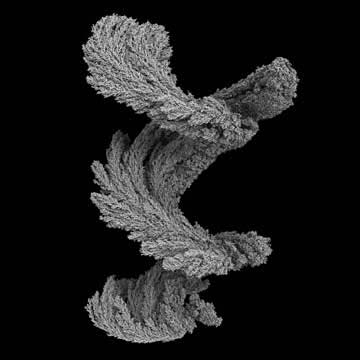



NEW MATH:
Recent Algorithmic Art
May 11-June 3, 2006
Reception for the artists May 11, 7-9pm

Andy Lomas From "Aggregation" Series
Andy Lomas
Charles Fairbanks
Tim Quinn
Hollis Cooper
Nathan Selikoff
Milos Rankovic
Thomas Briggs
Los Angeles Center for Digital Art presents an international group exhibit of artists using computer algorithms, math based image generators and custom software for the production of abstract works. The show includes videos of animated algorithmic renderings, architecturally based works, internet generated images, 3D stereoscopes, art based on organic growth, as well as interactive pieces where visitors can create their own images.
Andy Lomas is a mathematician, digital artist and Emmy award winning digital effects supervisor. His Aggregation series explores the complexity of organic form with intricate sculptural shapes generated by computer simulated growth systems. Using his own software to create the forms, biases and changes to environmental rules are used to create an incredible variety of structural shape.
Nathan Selikoff has abandoned the predefined processes of production to more fully explore the computational landscape of mathematics and beauty. He uses custom software to investigate strange attractors – visual representations of chaotic dynamical systems. Fascinated by the diversity and complexity of the raw images that come from simple sets of iterated functions, he enjoys the interplay of technical problem solving and artistic spontaneous interactivity.
Charles Fairbanks calls upon friends for an introduction: their laconic descriptions of the artist—ranging from "meaty" to "abstract dynamo"—lend linguistic thrust to his Googled Self-Portraits. The descriptions become keywords for a program to average the RGB data of the top fifty Google-Images. Determined by linguistic, personal, and virtual connections, the appropriated pictures become glowing color-fields of information while details linger at the threshold of perception.
Hollis Cooper believes virtual environments have opened a new era in the experience of architectural space. Digital representation has produced perspectives that are no longer based on physical space but instead on multiple-user organization and efficiency – a limitless number of vanishing points. She regards these developments optimistically, as a means of expanding our ability to suspend disbelief and project ourselves into the world around us, interacting more actively with and within it.
Tim Quinn is a nationally known Los Angeles sculptor and algorist. He has a long-standing love of recursion, which over the years he has applied to various visual material to produce a visually and conceptually stunning effect. His recent work explores a randomized kaleidoscope effect that defies easy understanding. Applying his own AppleScript Photoshop code to scanned images of his "Sculpey" objects, he achieves a global flattening of 3D space that doesn't flatten locally.
Thomas Briggs is a veteran of the art world with a 20 year history in computer animation production and teaching. As an animator/programmer he was often concerned with the mathematical representation of fluid, lifelike gesture. He realized that this notion could be inverted, that the gesture could be realized from mathematics directly, and used to create drawings which retain some connection to the scratch of pen on paper. He eschews algorithmic, or procedural processes, instead using simple periodic functions evolving over time.
Milos Rankovic received an Award for Doctoral Study in the Creative and Performing Arts from the UK’s Arts and Humanities Research Council (AHRC) to pursue his study of the relationship between creativity and commitment. One of the key goals of the study was to develop an aesthetically relevant notion of complexity, which he now describes as “the tip-splitting instability and the infinite precision of the lossy incompressible”. Inspired by Cairn-Smith’s ideas regarding the pre-biotic (and therefore pre-phenotypic) evolution, and as a way of gaining some practical insight and intuition about the implications of this theoretical work, Milos designed an evolutionary algorithm featuring aesthetic selection of images as “naked genes”. He implemented this algorithm as a computer program, ASNakedGene, that generated the images representing him in the show. Milos currently teaches digital art at the University of Leeds.
|
|

